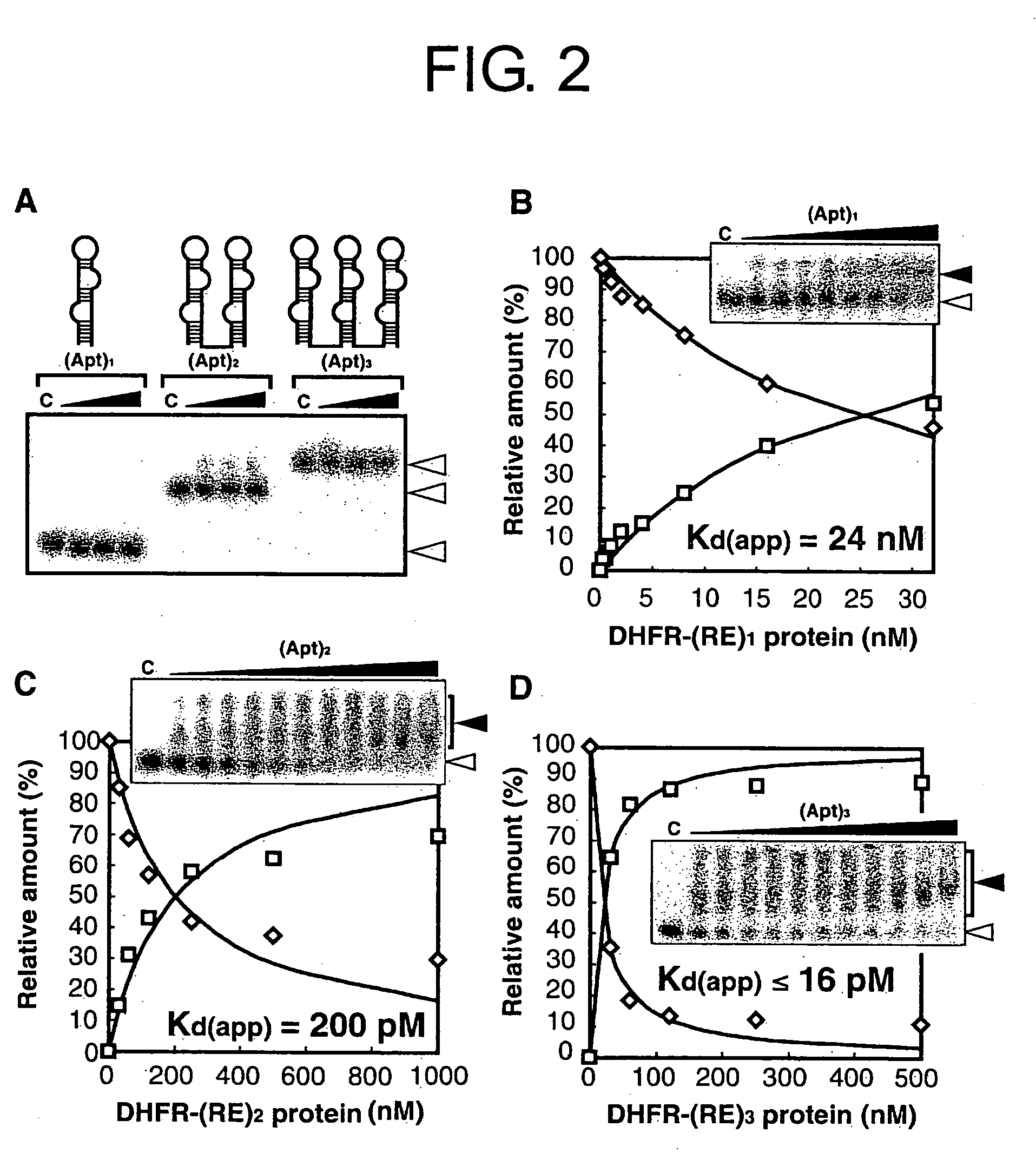Method for forming a stable complex comprising a transcription product and translation product of a dna encoding a desired polypeptide, a nucleic acid construct used for the method, a complex formed by the method, and screening of a functional protein and mrna or dna encoding the protein using the method
a technology of stable complex and transcription product, which is applied in the field of method for forming stable complex comprising, can solve the problems of limited library variety, low transfection efficiency, and limited sequence library variety, and achieve stable linkage between genotype and phenotype, without reducing sequence variety
- Summary
- Abstract
- Description
- Claims
- Application Information
AI Technical Summary
Benefits of technology
Problems solved by technology
Method used
Image
Examples
example 1
A. Methods
(A-1) Preparation of Three Types of Proteins [DHFR-(RE)n]
[0178] In the preparation of DHFR-(RE)1-3 fusion protein, the DHFR gene derived from plasmid pTZDHFR20 (Blakley, R. L., In Folates and Pterins; Blakley, R. L.; Benkovic, S. J., Eds.; Wiley: New York, 1985; pp. 191-253) comprising a PstI site at the 3′-end was inserted into plasmid pET30a (Novagen, Madison, Wis.). Sense and antisense oligonucleotides encoding RE peptide (38 amino acids; RKKRR QRRRP PQGSQ TBQVS LSKQP TSQSR GDPTG PKE (SEQ ID NO: 3)) were synthesized and allowed to anneal. The sequence was elongated using rTaq polymerase (Takara Shuzo Co., Kyoto, Japan). The resulting dsDNA was double-digested at the PstI and EcoT22I sites, and inserted into the PstI site at the 3′-end of the DHFR gene. The restriction sites for PstI and EcoT22I were bound to each other. Neither PstI nor EcoT22I cleaved the resulting ligated site. Thus, multiple units of RE peptide-encoding sequence were sequentially ligated into the ...
example 2
A. Materials and Methods
(A-1) Construction of Expression Vectors for Dihydrofolate Reductase (DHFR), Glutathione-S-Transferase (GST), and Streptavidin (StAv) Fused with Ricin-A Chain
[0202] pDHFR was constructed by inserting the DHFR gene derived from PTZDHFR20 into pET30a at the multi-cloning site. Furthermore, two sequences respectively encoding amino acids 1-404 (long spacer) and amino acids 195-315 (short spacer) of the geneIII sequence (for the geneIII sequence, see “In vitro selection and evolution of functional proteins by using ribosome display”, Proc. Natl. Acad. Sci. USA., May 13, 1997; 94(10) :4937-42) derived from pCANTABE5 (Pharmacia) were amplified using the primers described below. The resulting DNAs were digested with ECOT22I and PstI, and inserted into the PstI site downstream of the DHFR gene. The primers used are: forward primer for the long spacer: 5′-GTG GCG ATG CAT CGA CTG TTG AAA GTT GTT TAG CAAAAC -3′ (SEQ ID NO: 11); reverse primer for the long spacer: 5′...
example 3
[0232] To assess the general applicability of the ribosome-display system, the present inventors studied the stability of the ribosome-mRNA complex in the presence or absence of the termination codon, and further in the presence or absence of the additional interaction between the translated peptide and the mRNA in the ribosome-mRNA complex.
[0233] The additional interaction used by the present inventors was the interaction between a dimer of tandemly fused MS2 coat protein (MSp) and RNA sequence (named C variant (or Cv)) comprising a specific binding motif corresponding to the dimer.
[0234] Specifically, the construct shown in FIG. 16 was subjected to in-vitro transcription / translation, and the formed complex was selected by Ni-NTA agarose.
[0235] Thus, the efficiency of the system was improved by additionally using the mMSp-Cv interaction (FIG. 18). The mRNA recovery rate after selection was 0.46% after washing three times, and was significantly higher than-that (0.24%) in the abs...
PUM
 Login to View More
Login to View More Abstract
Description
Claims
Application Information
 Login to View More
Login to View More - R&D
- Intellectual Property
- Life Sciences
- Materials
- Tech Scout
- Unparalleled Data Quality
- Higher Quality Content
- 60% Fewer Hallucinations
Browse by: Latest US Patents, China's latest patents, Technical Efficacy Thesaurus, Application Domain, Technology Topic, Popular Technical Reports.
© 2025 PatSnap. All rights reserved.Legal|Privacy policy|Modern Slavery Act Transparency Statement|Sitemap|About US| Contact US: help@patsnap.com



